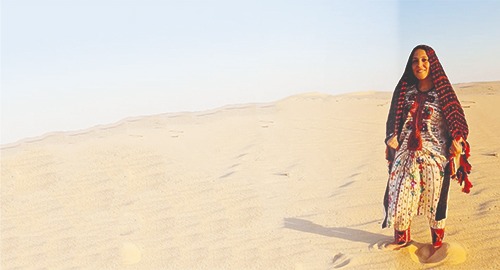Embroidery would never have become part of her life until she went to Siwa Oasis.
Amany Ali el-Zawawy, 36, moved from her home town Kafr el-Sheikh to Siwa to manage a small hotel three years ago to work in tourism.
However, she was so inspired by the colourful embroidery on women’s garment, she decided to go into the clothes making business herself.
“When I saw women stitching clothes, I was reminded of how I used to make clothes for my dolls,” el-Zawawy said.
“The clothes of Siwa are like beautiful works of art that tell the stories of the local heritage and beliefs,” she said an interview with The Egyptian Mail the weekly edition of The Egyptian Gazette.
Women wear bright colours with intricate embroidery in the home, but they wear black and white at weddings, she said.
“The richness of detail prompted me to use the Siwa style in making elegant fashion for today.”
Yet there was a snag. Siwa clothes are T-shaped and loose-fitting with puffed sleeves. They are heavy on the body, making them unsuitable for daily wear for the modern woman.
“I looked for fashionable, trendy designs, and I used the same types of embroidery, buttons and symbols that are characteristic of Siwa women’s clothing, but they are in a form that is simpler, functional and suitable for the weather,” she said.
El-Zawawy reduced the area for embroidery in the fabric, used bright colours for outdoors, and used modern cuts for dresses, skirts, trousers, blouses and shawls.
In Siwa they use silk, but she uses cotton and linen to keep the colours around the embroidery fast after repeated washing to suit hot weather.
“I used some Egyptian hand-made fabrics from Akhmim and Najada, so I am offering a purely Egyptian product,” she said.
We can learn about some of the features of Siwa culture through el-Zawawy’s designs, foremost of which is what is related to Siwa people’s belief in magic and the evil eye. Clothing is replete with motifs, such as the khamisa and the spider-shaped taglust that symbolise protection any evil energy.
El-Zawawy uses the vertical stripes on the tarqa, the bridal shawl of in Siwa Oasis, because they make the woman radiate light like the sun’s rays to illuminate her husband’s life, and the colours are inspired by nature.
The fish in Siwa is a fertility symbol and on the four sides of the black jacket you will find a group of triangles symbolising the achievement of happiness and hopes.
Siwa is a closed society, but el-Zawawy can co-operate with the women who almost never leave their homes.
“They are not open-minded, but they are friendly and welcome anybody who lives among them as long as we respect them and their special traditions. They also supported me with the information I needed in my project,” she explained.
“I persuaded some local women to embroider my designs after they and their husbands felt comfortable with me,” she said.






Discussion about this post